I. Prologue: The Antiquity and Distinct Identity of Rogan Painting
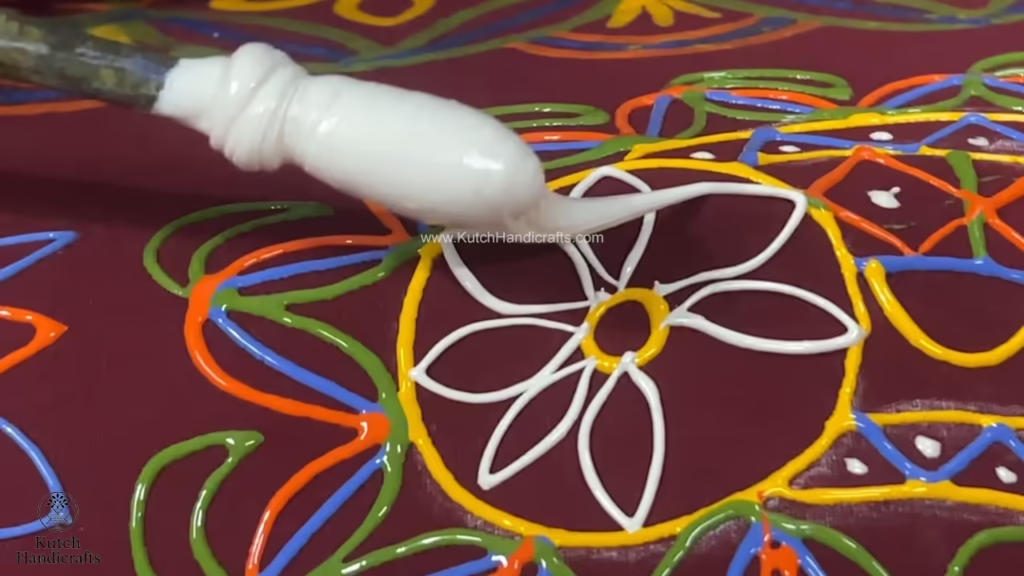
Defining the Oil-Based Textile Painting Tradition
Rogan art signifies an ancient and rare Indian textile painting tradition, distinguished by its technical method and resulting aesthetic effect. Fundamentally, it is characterized by the use of a thick, resinous, oil-based paint applied meticulously to fabric. This application method involves trailing or “floating” paint above the fabric without direct brushing. It yields a tactile, glossy, and distinctly sculptural quality. This sets it apart from nearly all other Indian textile crafts, which typically rely on weaving, dyeing, or embroidery. The craft’s historical significance is recognized officially. It has been awarded Geographical Indication (GI) status specific to the Kutch district of Gujarat.1 The Unwritten History of Oil painting: Ashish Kansara.
The etymological background of the term “Rogan” is very old. It reflects the craft’s deep and multifaceted history across Central and South Asia. Yet, the lineage linked to Madhapar, Kutch, often anchors its heritage to a deeper linguistic foundation. The Sanskrit word Rangan ($रङ्गन्$), which means “to add color” or “to dye”.2 Indian origin directly to Kshatriya communities. This distinction is crucial for identifying the unique historical trajectory of the Madhapar center. It diverges from the more commonly cited narratives focused solely on fake influence.
Introducing Ashish Kansara: The Guardian of Gujarat’s Legacy
The preservation and contemporary evolution of the Rogan art form in Madhapar depend on the dedication of Ashish Shantilal Kansara.3 He was born in 1975. Kansara and his family serve as the custodians of this specific, distinct lineage of Rogan painting. This lineage dates back over 1,550 years. The Kansara family’s connection to the craft is generational. It traces back to Ashish’s grandfather, Jamnadas Vastaram Kansara. He was also a skilled Rogan artist. But, he sought different employment to sustain his family during periods of economic hardship.
The Madhapar center’s continued existence is a testament to cultural resilience. Ashish Kansara developed a profound connection with the unique craft during his early teens. His preservation efforts continued despite immense regional and economic pressures. These pressures included the catastrophic 2001 Bhuj earthquake. There was also sustained competition from increasingly affordable machine-printed fabrics that threatened to remove traditional crafts entirely. The report focuses the contemporary narrative on artisan Ashish Kansara. It positions him as the vital torchbearer. He upholds the ancient traditions of the Kshatriya lineage of Rogan painting in Gujarat.
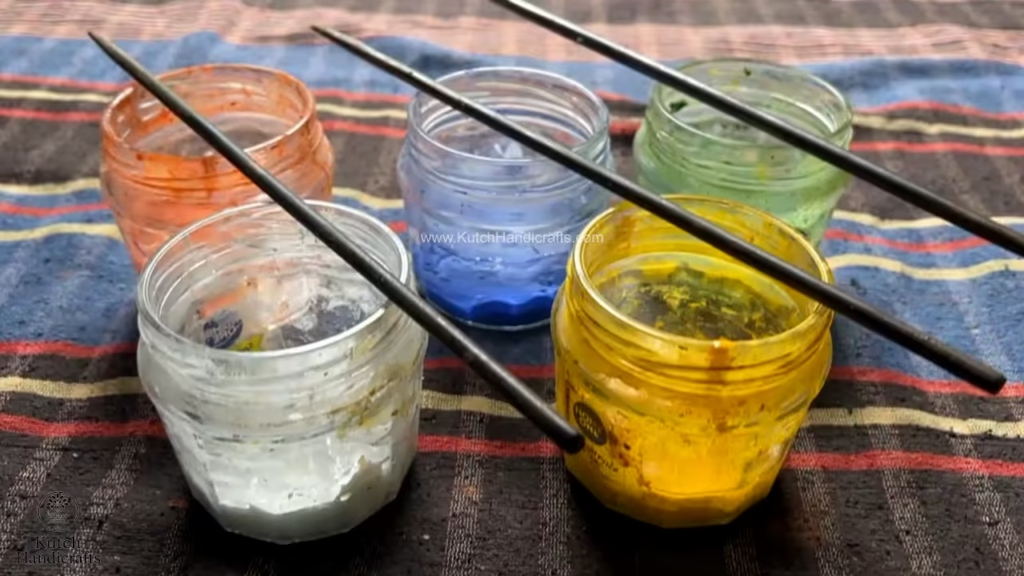
II. Contested Narratives of Origin: The 1,550-Year Trajectory of the Drying Oil Technique
The Ancient Pan-Asian Reach of Rogan
Rogan painting, when defined by its core technical method, is recognized fundamentally as the “drying oil technique”. The longevity of this oil-based approach has necessitated a reassessment of its origins far beyond the Gujarat region. Scholarly investigations give compelling evidence. This includes UNESCO research conducted in 2008. Buddhist Rogan paintings date back as far as the 5th or 6th century C.E.. This historical reach spans geographically from Patliputra (Bihar) to the ancient Buddhist sites of Bamiyan in Afghanistan. This external archaeological evidence strongly validates the 1,550-year old.4 It suggests that the craft was disseminated across trade networks like the Silk Roads. The craft evolved over centuries as both a decorative art and a medium for religious iconography.
Delineating the Dual Lineages in Kutch
In the Kutch district, two distinct lineages of Rogan painting are documented. They differ significantly in their cultural origins, history, and practice.
The Kansara tradition in Madhapar maintains a link to the older history of the craft. It originates among Hindu Kshatriya communities.5 This lineage preserves the knowledge of the delicate freehand styles. It continues a tradition practiced in Kutch for over so many years by the Kansara family specifically. This tradition is much longer among the associated Kshatriya communities.
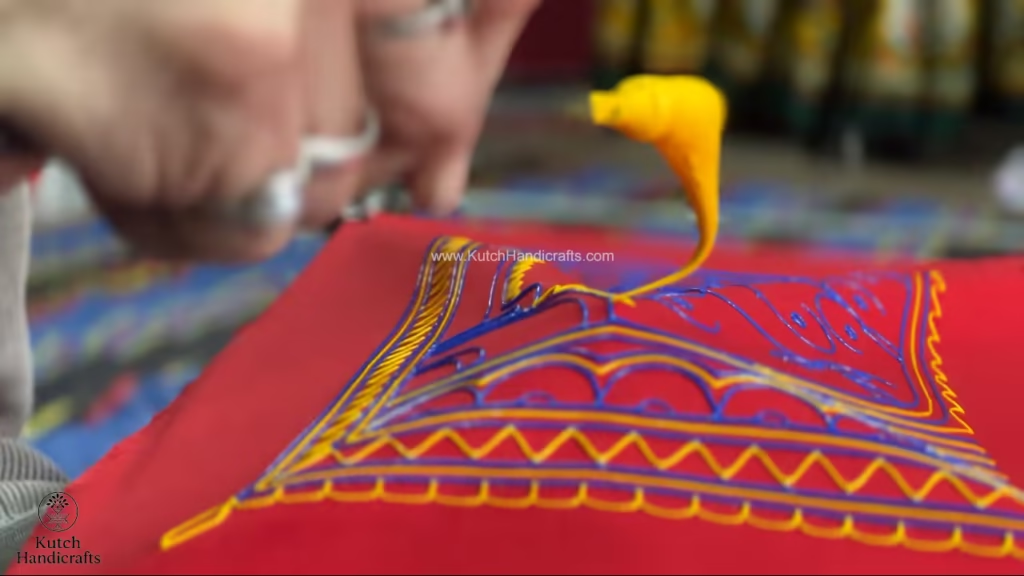
Societal Context and Market Survival
The survival trajectory of the Kansara family in Madhapar offers unique insights into the art’s economic history. Historically, Rogan textiles were largely seasonal commodities. They were purchased predominantly by women of the Hindu lower castes. The textiles were used to decorate clothing for wedding ceremonies. This highly specialized market made the craft extremely vulnerable to external competition. Cheaper, mass-produced textiles rose in the late 20th century. This made labor-intensive Rogan products too expensive for the local consumer base. As a result, many traditional Hindu artisans, including those in the Kansara family, abandoned the craft or sought agricultural work.
The Kansara family were custodians of the Kshatriya lineage.6 They later became pioneers of religious fine art. This allowed them to tap into a separate, higher-value patronage. Kansara art was traditionally consumed by a specific consumer market, specifically lower-caste ceremonial textiles. Nonetheless, the Kansara family’s specialized focus allowed them to access a separate market. This market was for high-status, long-lasting religious fine art. This shielded them from serious economic pressures. As a result, they had a stable, high-value source of income. This stability allowed the tradition to persist even when the traditional textile market collapsed.
Table Title: Rogan Art Historical Chronology and Lineage Comparison
| Attribute | Kshatriya/Kansara Tradition (Madhapar) | Kansara Tradition (Madhapar) | Source Documentation |
| Estimated Origin Date | Up to 1,550 years (5th/6th Century C.E.) | Approximately years (16th Century) | 1 |
| Primary Cultural Association | Hindu/Kshatriya community (Tracing roots to Patliputra/Bamiyan) | Hindu Kansara (Kshatriya) community (Tracing roots to Gujarat) | 1 |
| Traditional Motifs | Freehand, abstract symbols, geometrical patterns, Pioneering Deity Portraits | Symbolic Tree of Life, floral motifs, geometric designs (traditionally non-figurative) | 6 |
| Stance on Female Artisans | Pioneer: Actively training 21 women; inclusive community model established by Ashish and Komal Kansara | Traditional Exclusion: Historically male-exclusive; only recently adapted to train women for survival/demand | 3 |
III. The Chemical Alchemy: Manufacturing the Rogan Gel and the Artisan’s Tools
The Arduous Preparation of the Rogan Paste
The distinct texture of Rogan art relies entirely on precise preparation. The luminosity also depends on the time-intensive process of preparing the base paint.7 The essential raw material is castor seed oil. Artisans also use linseed, walnut, or poppy seed oil, castor oil..
The oil undergoes a transformative thermal process. It is placed in a vessel and cooked over heat for prolonged duration. This typically lasts 8 to 12 hours but often extends up to two continuous days. This process must be conducted in an open environment due to the powerful odor emitted during the prolonged boiling period. The goal is to reduce the oil and make it thicker. It achieves a viscous, sticky residue, which is the foundational Rogan gel. This chemical conversion is not merely cosmetic; the high-heat, prolonged boiling creates a chemically stable, highly durable resinous paint base. This inherent robustness explains the art form’s longevity. It confirms the suitability of the “drying oil technique” for ancient applications. These applications include iconography that date back over 1,500 years. The paste consistency is critical. It must be pliable enough to be trailed in “thread-like” strands. At the same time, it must be thick enough to keep its three-dimensional shape. It should not bleed into or fully collapse onto the fabric.

Pigmentation, Mixing, and Storage
Once the Rogan gel has cooled, the pigmentation stage begins. Natural dyes, along with chalk powder, are carefully incorporated into the thick oil. The components are meticulously rubbed and mixed to guarantee a uniform blend. This also ensures proper binding of the pigment to the dense oil gel. Traditionally, artisans use a stone for this mixing. Rogan artisans Ashish Kansara8 prefer a 5 color palette. They use only five colors like blue, green, yellow, and orange. These colors are designed to achieve the greatest brilliance against the dark base fabrics typically chosen for the artwork. Prepared Rogan gel colors are stored in containers. The containers are submerged in water. This step is crucial for maintaining their texture and integrity over time.
Technical Application and the Stylus Precision
The application of Rogan art is a highly specialized skill demanding exceptional precision and years of practice. The primary tool is a fine metal stylus, or tulika. Unlike conventional painting that utilizes brushes to transfer paint, the artisan expertly manipulates the paint strand. Their hands hover both beneath and above the fabric. The technique involves the artisan using their palm as an immediate mixing palette. The artisan rubs the thick Rogan gel on their palm. This action generates friction and localized heat. The heat temporarily softens and thins the color. This thermal manipulation grants the artist the minute control necessary to accurately “float a thread of paint over the cloth”. The designs are created freehand.9 Any errors can’t be corrected once the paint has begun to cure. Thus, the technique requires immense focus and unwavering precision. Finally, the painted fabric is traditionally sun-dried. This solar curing process ensures durability. It hardens the resinous paint base and sets the artwork permanently.
Table Title: The Rogan Process: Material Transformation
| Process Stage | Key Material(s) | Duration & Need | Technical Outcome |
| Oil Preparation (Rogan) | Castor Oil, Linseed, Walnut, Poppy seed) | 8-12 hours up to 2 days of continuous boiling in an open area | Viscous, sticky, resinous gel consistency (Rogan) |
| Color Formulation | Rogan Gel, Natural Dyes, Chalk Powder | Rubbing/Grinding with stone | Vibrant, glossy, pliable oil-based paste |
| Application Tooling | Metal Stylus (Tulika); Artisan’s Palm | Heat generated by rubbing to temporarily thin the paint thread | Freehand “floating” of thread-like strands onto dark fabric |
| Curing/Finishing | Sunlight/Solar Curing | Required for durability and setting | Permanent, tactile, and sculptural finish |
IV. The Techniques of Mastery: Ashish Kansara’s Unique Repertoire of Three Styles Rogan Painting
The Context of Preservation: Kansara as the Sole Custodian
Rogan painting is historically documented as encompassing three distinct methodological styles: Rogan Chhap, Nirmika Rogan art, and Varnika Rogan art.10 Although traditional Rogan art (Chhap) is practiced by many artisans in Madhapar and Kutch, Nirmika Rogan is extremely rare. Varnika Rogan is also exceptionally rare. These styles represent lost or highly specialized techniques. Ashish Kansara’s preeminent status is undisputed. He is the only artist known worldwide. He retains and actively practices the knowledge of all three historical Rogan painting styles. This unique command forms the cornerstone of his efforts to preserve the entire technical history of the craft.
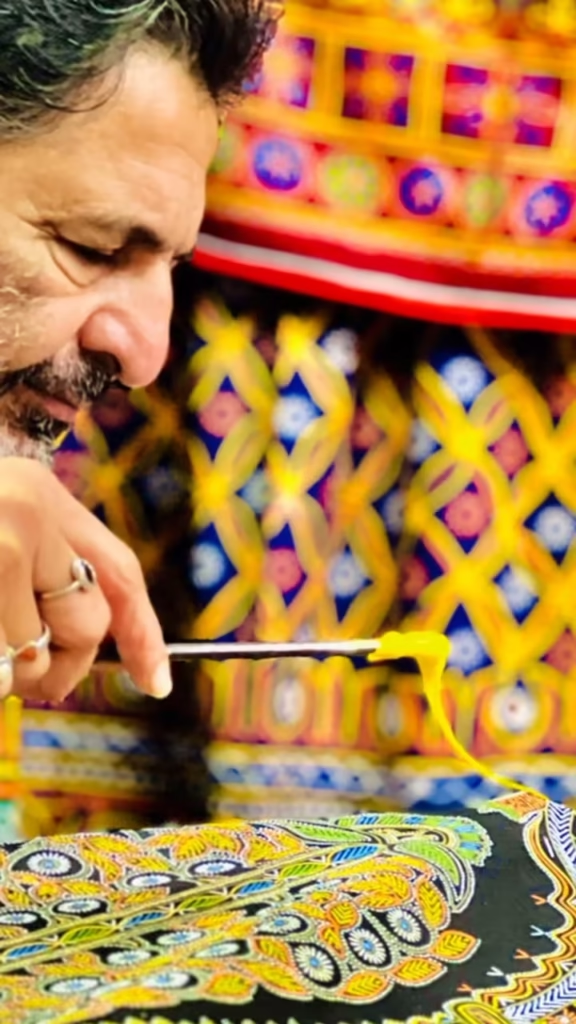

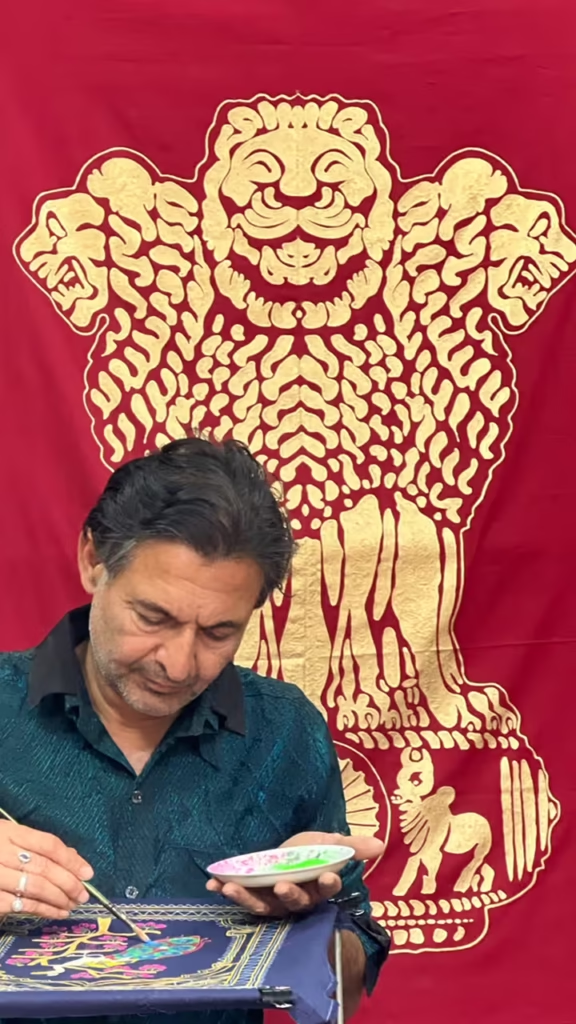
Rogan Chhap: The Freehand Zenith
Rogan Chhap signifies the traditional style, which is often used interchangeably with “Rogan art” due to its widespread recognition. This technique involves the freehand creation of intricate, elaborate motifs like the Tree of Life11 and stylized peacocks. The most distinguishing feature of Chhap is the mirror image technique. The artisan paints only half of the intended symmetrical design on the fabric. Once this half is finished, the fabric is carefully folded and pressed. This transfers the wet paint onto the untouched second half. It creates a precise, symmetrical mirror image without the need for stencils or complex measurement.
Nirmika Rogan (Rogan Print): Precision and Scalability
Nirmika Rogan is also known as Rogan Print. It is a specialized, mold-based method. This method shows a radical departure from the freehand approach. The process begins with the preparation of the Rogan paste, utilizing castor or other suitable oils and natural dyes. Crucially, the paste is then filled into intricately crafted brass molds. These molds need specialized skill. Sunars (goldsmiths) often craft them using the Aari cutting technique to guarantee fine detailing. The artisan then presses the mold onto the fabric using a wooden stick, ensuring a precise, uniform impression.
The existence and revival of Nirmika Rogan art by Kansara suggest a significant historical implication. This scalable printing technique would have been necessary during a period of high economic demand for Rogan art. It hints at a lost history where the craft moved toward industrial-scale production centuries ago. This occurred before its eventual collapse due to cheap machine prints. The utilization of these specialized, high-detail brass molds points to a highly structured, collaborative historical ecosystem. By mastering and utilizing Nirmika Rogan art today, Kansara enables faster production and consistency across multiple items. This technical ability is crucial for strategic market development. It allows the Madhapar center to produce scalable products like sarees and scarves. These products keep design uniformity and effectively future-proof the art against contemporary market demands for volume and consistency.

Varnika Rogan art: Embellishment and Enhanced Coloration
The third style, Varnika Rogan art, is the most decorative and specialized, typically involving extra embellishments and enhanced colors. This technique starts similarly, with a base design painted, usually freehand. The key difference lies in the next detailing. Extra colors are layered over the base design. This process sometimes requires the use of a white rogan paste. Furthermore, decorative elements like glitter or mica are applied to give sparkle and shine. This method is highly ornamental. It suggests that Varnika Rogan art was historically reserved for garments intended for high-status patrons. It was also used for ceremonial purposes. This showcases the full expressive range of the drying oil technique.
V. Artistic Innovation: The Introduction of Figurative and Devotional Motifs
Challenging the Abstract Tradition
For much of its documented history in Kutch, Rogan art was defined by highly symbolic, abstract motifs. Traditional Rogan motifs were used. These included the universally recognized Tree of Life and geometric patterns. The motifs also encompassed intricate floral and animal figures like peacocks and elephants. The established aesthetic of the craft was defined by its symbolic and non-figurative nature. This restriction was rooted in centuries of practice, limiting Rogan to complex patterns and symbols rather than representational imagery.
Pioneering Deity Portraits: A Fine Art Shift
Ashish Kansara initiated a significant artistic revolution.12 He introduced a new genre into the Rogan repertoire. This genre includes stunning portraits and fine art paintings of Hindu and Jain deities. This innovation represented a radical shift from textile decoration to fine art iconography. Kansara is celebrated for his detailed figurative depictions of religious icons. These include Shree Raja Ram Darbar13, Shri Rama, Shri Swaminarayan, and Shri Mahavir. He also depicts other icons accepted by Jain communities.
This pioneering effort carries profound historical significance that extends beyond mere modernization. By successfully rendering human and divine forms, Kansara is arguably reconnecting the Kutch tradition with the craft’s deepest, 1,550-year-old origins. The evidence of Buddhist Rogan paintings in Bamiyan (5th/6th century C.E.) is accepted, the technique was historically utilized for high-status, sacred iconography. Kansara’s move toward high-detail deity portraits reinstates Rogan art’s ancient role. It focuses on creating sacred figurative imagery. This provides strong internal coherence to the Kshatriya lineage’s of preserving the oldest version of the craft.14
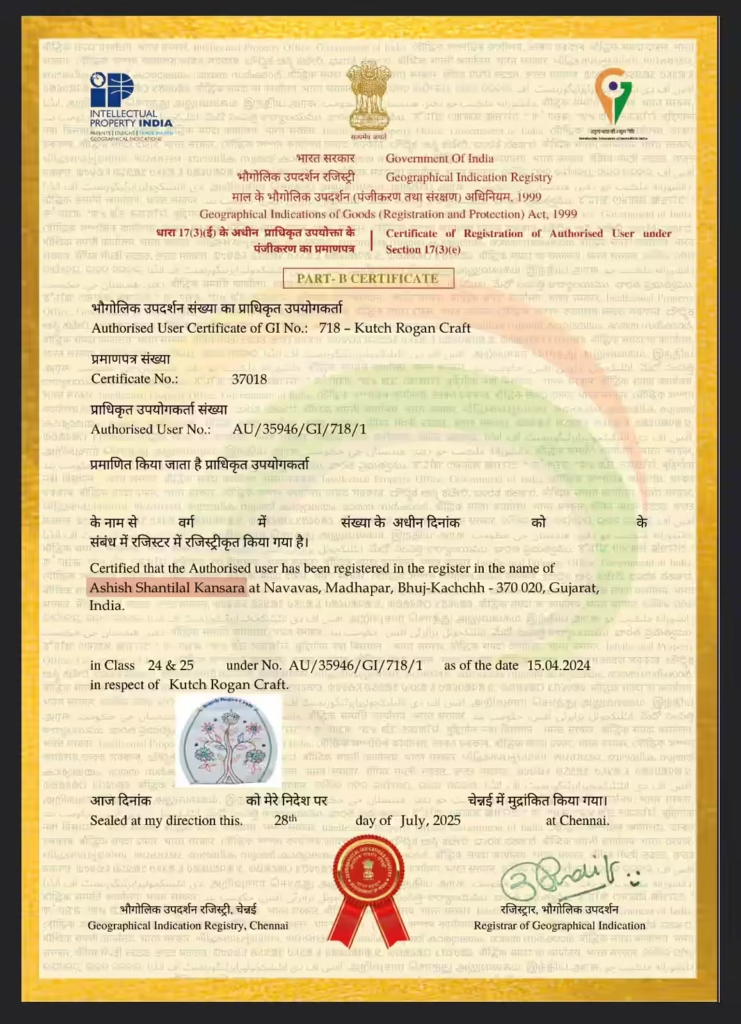

Strategic Expansion into Modern Applications
To guarantee the economic viability of the tradition in the modern era, Kansara implemented a strategy of product diversification. He has actively expanded the application of Rogan art beyond traditional ceremonial textiles like lehengas, odhani, and sarees. He has created modern marketable items, like wallets, wall pieces, and home décor items. This approach has broadened the craft’s market appeal. It has also created different revenue streams. This strategic shift is vital, enabling the craft to survive independent of the volatile traditional textile and wedding markets. Check Authenticity of Rogan Art Products15 before buy
VI. The Madhapar Center: Resilience, Empowerment, and Succession
Crisis and Cultural Resilience
The history of the Kansara family is marked by profound cultural resilience against overwhelming economic and natural challenges. Inexpensive machine-printed fabrics posed a pervasive economic threat. This threat forced Ashish Kansara’s grandfather to seek different employment. This situation illustrates the fragility of the craft. Ashish Kansara himself remained resolute despite facing catastrophic setbacks, notably the destructive 2001 Bhuj earthquake. He was dedicated to preserving Rogan painting. He also advanced it despite these challenges. His efforts became a powerful narrative of cultural commitment in Kutch.
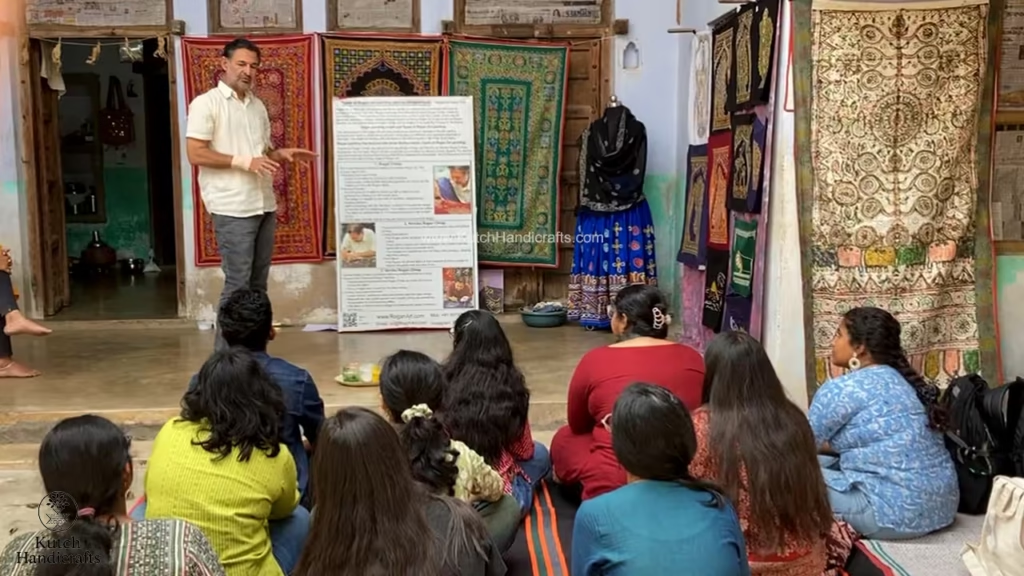
Socio-Economic Empowerment of Women
The Madhapar center has transformative elements. Its commitment to socio-economic empowerment distinguishes it from the traditional exclusivity often linked to Rogan art. Historically, Rogan art was a craft practiced strictly by male members of the practicing family. Ashish Kansara and his wife, Komal Kansara, actively broke these traditional gender norms.
Kansara has conducted workshops and training sessions primarily in Madhapar, successfully training at least 21 women from the local community. Komal Kansara is a skilled practitioner. She is also a dedicated teacher. She leads this effort to pass the skills on to a new generation of artisans. This initiative provides the participating women with a sustainable livelihood. It effectively turns Madhapar into a collective hub for the ancient craft. This model is not merely social empowerment; it is a critical economic mechanism. By diversifying the labor pool to include women, Kansara ensures continuous production capacity. Many women often seek stable, home-based employment. Kansara also hedges against the risk of male artisans leaving the village for better-paying, non-traditional employment. This female-inclusive community model strengthens the Madhapar center by making it more robust. It ensures the art’s survival through community strength instead of family secrecy.

Passing the Stylus: The Kansara Dynasty of Artistry
The continuity of the Madhapar tradition is secured through the active participation of the next generation. Komal Kansara is a key figure in training the younger generation. The most visible sign of generational succession is their son, Vasudev Kansara. Vasudev is recognized as one of the youngest practitioners of the 1,550-year-old art form.
His skill was publicly recognized in August 2023. He was only in the 7th standard. Yet, he participated in a live art competition organized by the Living and Learning Design Centre (LLDC). Vasudev Kansara competed against seasoned artists. He received an award for his exceptional skills and precision. This accomplishment reaffirmed the multi-generational commitment. It secured the future viability of the Madhapar lineage.
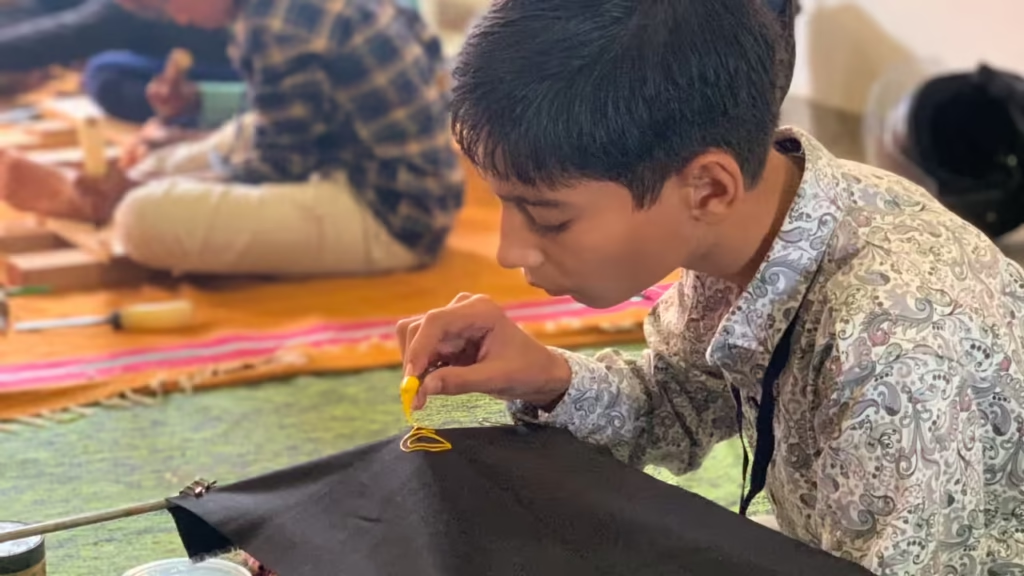
VII. Global Recognition, Market Strategy, and Future Sustainability
Recognition and High-Profile Outreach
Ashish Kansara’s dedication and artistic innovation have garnered significant domestic recognition. He has received many accolades. These include the Craftcentres Winner Award in 2019. He also received the Vidisha Craft Award for Artists in 2021. His work has been featured in high-profile collaborations with designers and showcased at events like RAKT fashion shows. These efforts strategically elevate Rogan art from a regional craft. They transform it into a luxury heritage product within contemporary design and fashion circles.
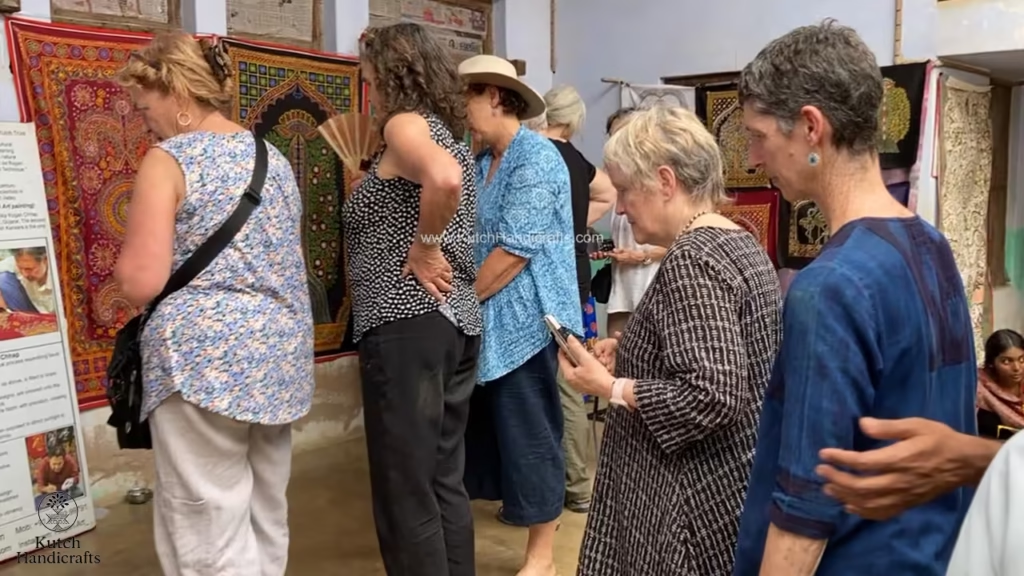
The Madhapar Market Strategy: Internal Diversification
The sustainability of the Madhapar center is driven by a comprehensive market strategy defined by diversification across three critical vectors:
- Technical Diversification: The exclusive mastery of all three Rogan styles is exploited commercially. Nirmika Rogan art (printing) is utilized for creating scalable and consistent patterns. These are required for commercial textiles. Rogan Chhap stands as the zenith for bespoke artistry. Varnika Rogan art (embellishment) is reserved for high-end customization.
- Product Diversification: The shift from relying exclusively on ceremonial textiles has evolved. The creation of modern, marketable lifestyle goods, like wallets and home décor, is now included. Additionally, high-value fine art featuring deity portraits ensures a broader and more stable revenue base.
- Demographic Diversification: The establishment of an empowered, female-inclusive community production hub guarantees a stable and dedicated workforce. This setup mitigates the risk of labor depletion inherent in traditional, exclusive models.
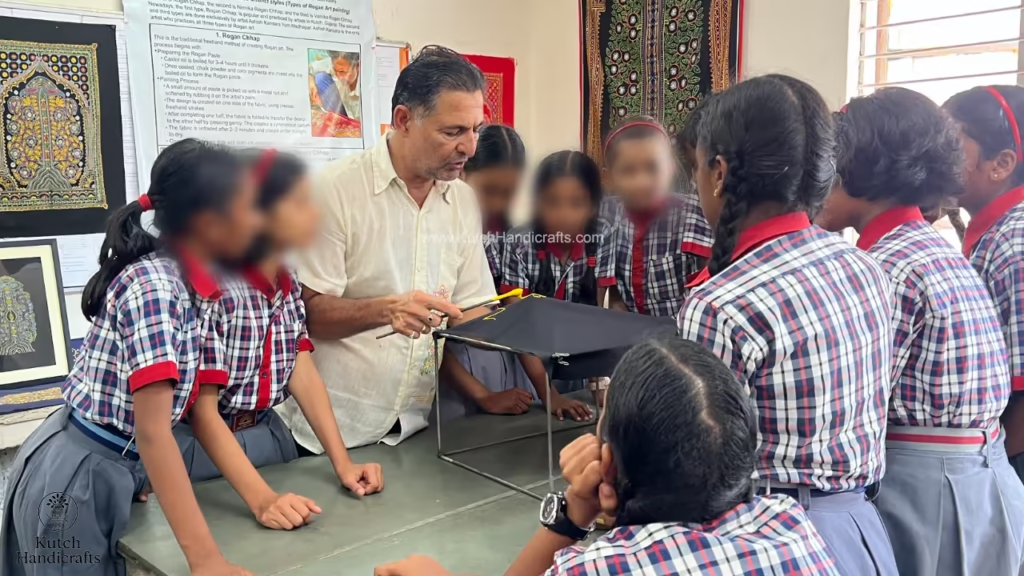
Conclusions
The Rogan art preserved and advanced by Ashish Kansara in Madhapar, Kutch, is much more than a 200-year-old textile tradition. It signifies a unique and continuous heritage of the 1,550-year-old drying oil technique. The Kshatriya lineage distinguishes itself through its foundational connection to the Sanskrit term Rangan. It is linked to the ancient Kshatriya communities. It is also noted for its pioneering innovations under Ashish Kansara.
Kansara holds a unique status as the world’s only master of the three historical Rogan techniques: Rogan Chhap, Nirmika Rogan Art, and Varnika Rogan Art. This is essential for the craft’s technical preservation. Furthermore, he introduces complex, figurative deity portraits. This shows a critical artistic restoration. It reconnects the modern practice with the technique’s ancient use in religious iconography. Economically, the Madhapar center has demonstrated superior structural resilience. It adopts an inclusive, empowerment-focused model. This model trains women artisans and leverages scalable techniques like Nirmika Rogan. This approach is comprehensive. It ensures that the tradition remains a living, breathing art form. This enables it to evolve and thrive in the contemporary marketplace. By supporting these strategic efforts, the longevity of this rare and intricate Indian heritage craft is secured for future generations.
Reference
- Kutch Rogan Craft ↩︎
- Rogan Painting ↩︎
- Ashish Kansara ↩︎
- Rogan Art: A 15 century year-old craft thrives in modern times ↩︎
- Rogan Art Kutch: Ancient India and Afghanistan to Modern-Day ↩︎
- Ancient intellectual Indian rogan art by Ashish Kansara ↩︎
- Rogan painting paste Making ↩︎
- Ashish Kansara ↩︎
- How to Rogan art ↩︎
- Three Styles of Rogan Art ↩︎
- Tree of life Rogan art ↩︎
- Rogan art by Ashish Kansara ↩︎
- Kutch artist makes Rogan art piece of Raja Ram Darbar ↩︎
- Rogan painting ↩︎
- Check Authenticity of Rogan Art Products ↩︎
Pingback: Rogan Painting — The Ancient Technique Behind Early Oil Art | Nirona